The Turtle Nebula is a planetary nebula located approximately 5,400 light-years away in the northern constellation Hercules. It has an apparent magnitude of 9.30. It is listed as NGC 6210 in the New General Catalogue.
The nebula has an apparent size of 40 by 30 arcseconds. It is roughly ellipsoidal in shape. It is composed of a bright inner region about 13 by 16 arcseconds across and a larger outer region that contains a pair of tubular structures. The inner nautilus shell is expanding at 19-24 km/s.
Like all planetary nebulae, the celestial Turtle was formed when an aging star reached the end of its life cycle and cast off its outer gaseous envelope.
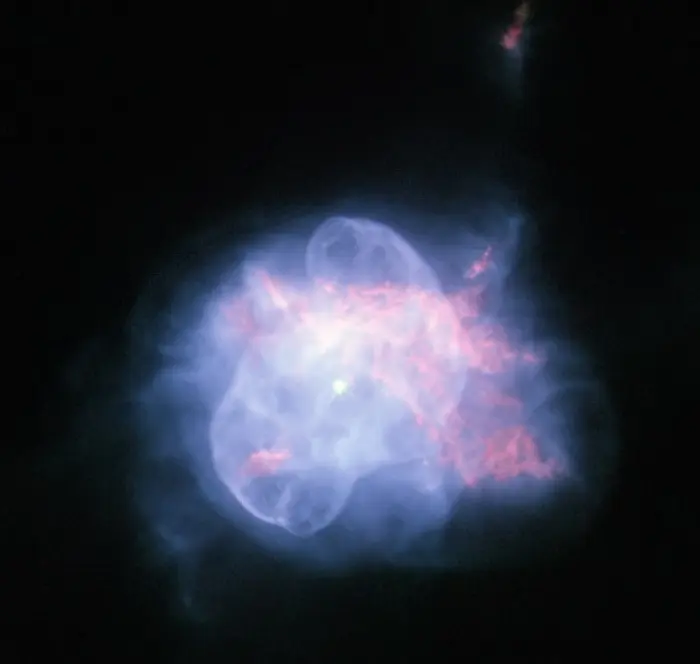
The NASA/ESA Hubble Space Telescope has taken a striking high resolution image of the curious planetary nebula NGC 6210. Located about 6500 light-years away, in the constellation of Hercules, NGC 6210 was discovered in 1825 by the German astronomer Friedrich Georg Wilhelm Struve. Although in a small telescope it appears only as a tiny disc, it is fairly bright. NGC 6210 is the last gasp of a star slightly less massive than our Sun at the final stage of its life cycle. The multiple shells of material ejected by the dying star form a superposition of structures with different degrees of symmetry, giving NGC 6210 its odd shape. This sharp image shows the inner region of this planetary nebula in unprecedented detail, where the central star is surrounded by a thin, bluish bubble that reveals a delicate filamentary structure. This bubble is superposed onto an asymmetric, reddish gas formation where holes, filaments and pillars are clearly visible. This picture was created from images taken with Hubble’s Wide Field Planetary Camera 2 through three filters: the broadband filter F555W (yellow) and the narrowband filters F656N (ionised hydrogen), F658N (ionised nitrogen) and F502N (ionised oxygen). The exposure times were 80 s, 140 s, 800 s and 700 s respectively and the field of view is only about 28 arcseconds across. Image credit: ESA/Hubble and NASA (CC BY 3.0)
The central star of NGC 6210 is catalogued as HD 151121. It shines at magnitude 12.66. It has a hydrogen-rich spectrum and has been given the spectral type O(H) or Of/[WR].
The star has an estimated effective temperature of 65,000 K. It is believed to have started its life with a mass of only 0.9 solar masses. It is currently losing material at 2,180 km/s, with an estimated mass loss rate of 2.2 × 10−9 M☉ yr−1.
Planetary nebulae are formed by intermediate-mass stars when they evolve into red giants. They lose a lot of their initial mass as they approach the late stages of their lives. The progenitor stars typically have a mass in the range between 0.8 and 8 solar masses. More massive stars usually go out as supernovae.
Sun-like stars spend billions of years of their life on the main sequence, fusing hydrogen in their cores. Once they exhaust their supply of hydrogen, they start fusing heavier elements and generating less energy through the fusion. As a result, gravity starts to compress the stellar core and the core temperature rises, reaching about 100 million kelvin. This, in turn, causes the outer layers to expand and become less stable.
When the star reaches the asymptotic giant branch (AGB), it starts to lose material at an increased rate. It can lose up to 70% of its mass though a strong stellar wind.
As the star vents its atmosphere into space, the exposed core eventually becomes hot enough (> 30,000 K) to ionize the expelled material. As a result, we see the glowing expanding layers of gas as a bright planetary nebula.
The planetary nebula stage is a relatively short episode in the evolution of stars. It lasts only about 10,000 years. Eventually the clouds of gas disappear into the interstellar space and the central star cools and stops giving off enough energy to excite the expanding nebula.
The Turtle Nebula has a jet feature in the northwestern portion, which indicates that the central star is expelling material in two or as many as four opposing directions. The fast wind streaming from the star is powering the opposing jets.
The material expelled from the star is flowing out through the holes it created in the expanding shell. The holes are directing the outflow of the material.
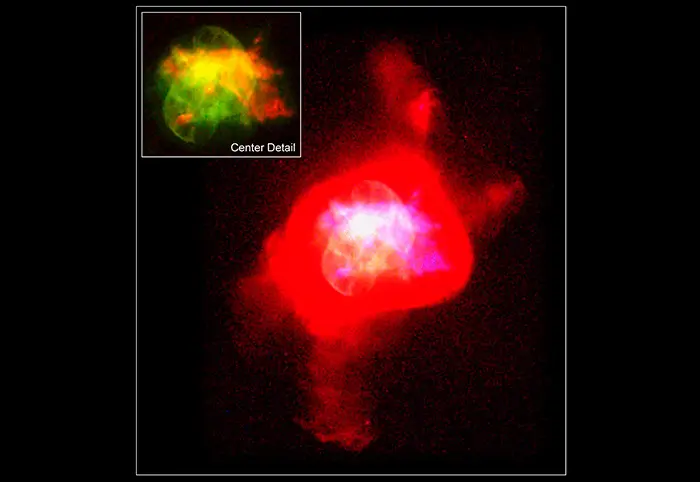
The NASA/ESA Hubble Space Telescope has shown us that the shrouds of gas surrounding Sun-like stars at the end of their lives (called planetary nebulae) come in a variety of strange shapes, from an “hourglass” to a “butterfly” to a “stingray.” With this image of NGC 6210, the Hubble telescope has added another bizarre form to the rogues gallery of planetary nebulae: a turtle swallowing a seashell. Giving this star such a weird name is less of a challenge than trying to figure out how central stars create these unusual shapes. The remarkable features of this nebula are the numerous holes in the inner shells with jets of material streaming from them. These jets produce column-shaped features that are mirrored in the opposite direction. The multiple shells of material ejected by the central star give this planetary nebula its odd form. In the “full nebula” image, the brighter central region looks like a “nautilus shell”; the fainter outer structure (colored red) a “tortoise.” The central star is the white dot in the center. Image credit: Robert Rubin and Christopher Ortiz (NASA Ames Research Center), Patrick Harrington and Nancy Jo Lame (University of Maryland), Reginald Dufour (Rice University), and NASA/ESA (CC BY 4.0)
Facts
The nebula NGC 6210 was first spotted by the French astronomer Jérôme Lalande n March 22, 1799. However, Lalande recorded the object as “star-like,” not realizing that it was not a star.
The Baltic German astronomer Wilhelm Struve is usually credited for the discovery of the nebula. He observed it in 1825 while looking for double stars with a 9.6-inch Fraunhofer refractor in Tartu, Estonia. He published his discoveries in his Dorpat Catalogue in 1827.
Danish astronomer John Louis Emil Dreyer, who compiled the New General Catalogue, described NGC 6210 as a “planetary nebula, very bright, very small, round, disc and border.”
In June 2023, the Turtle Nebula became the first object to be captured by the Keck Cosmic Reionization Mapper (KCRM) at the W. M. Keck Observatory on Mauna Kea, Hawaii. Operated by the California Institute of Technology (Caltech) and the University of California, KCRM is designed to provide scientists with new insights into the Epoch of Reionization, the period when the first stars and galaxies started to form in the young universe.
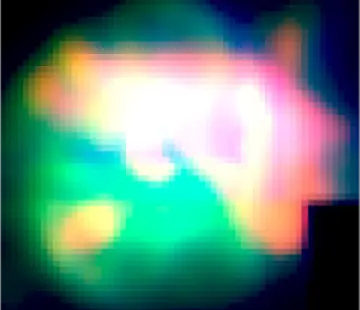
KCRM’s first-light image of the Turtle Nebula, which consists of a hot star that blew off its outer layers, expelling a glowing shell of gas and dust. Credit: C. Martin, Caltech/Keck Observatory/NASA/STScI (PDM 1.0)
Location
The Turtle Nebula lies in the region of the Keystone, a relatively bright asterism that outlines the torso of the celestial Heracles. The nebula appears near the yellow giant Kornephoros, the brightest star in Hercules, in the direction of the bright Vega in Lyra.
In small telescopes, NGC 6210 appears as a fuzzy star. In 4-inch and larger telescopes, it looks like a bluish-green elongated disk.
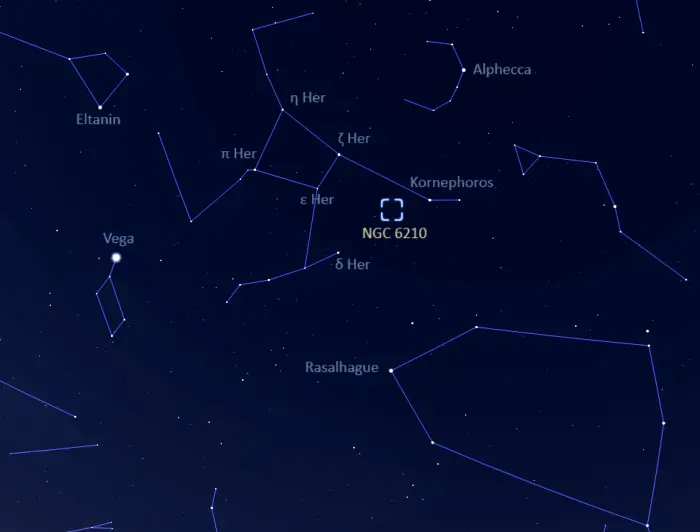
The location of the Turtle Nebula (NGC 6210), image: Stellarium
The best time of the year to observe the Turtle Nebula and other deep sky objects in Hercules is during the month of July, when the constellation appears higher above the horizon in the early evening.
At declination +23° 47’, NGC 6210 is visible from locations north of the latitude 66° S.
Turtle Nebula – NGC 6210
| Constellation | Hercules |
| Object type | Planetary nebula |
| Right ascension | 16h 44m 29.5191019368s |
| Declination | +23° 47′ 59.421958296″ |
| Apparent magnitude | 9.30 |
| Apparent size | 40 x 30 arcseconds |
| Distance | 5,400 ± 1,300 light-years (1,700 ± 400 parsecs) |
| Radius | 0.5 light-years |
| Names and designations | Turtle Nebula, NGC 6210, PN G043.1+37.7, PN ARO 5, PN VV 82, PN VV’ 143, PK 043+37 1, HD 151121, BD+24° 3048, AG+23 1564, PLX 3808.00, IRAS 16423+2353, 2MASX J16442953+2348003, PPM 105169, FIRST J164429.4+234800, WISE J164429.50+234759.8, WEB 13838, WISEA J164429.47+234759.4, GCRV 9624, TYC 2045-22-1, Gaia DR2 1299564195037054592, Gaia DR3 1299564195037054592, CCDM J16444+2348A, IDS 16403+2359 A |
Images
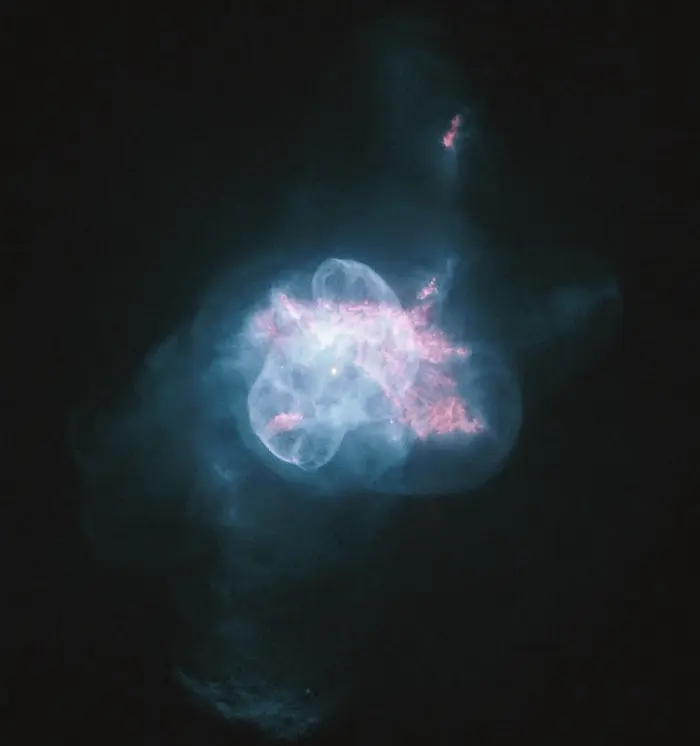
The Turtle Nebula (NGC 6210), image credit: Judy Schmidt (CC BY 2.0)
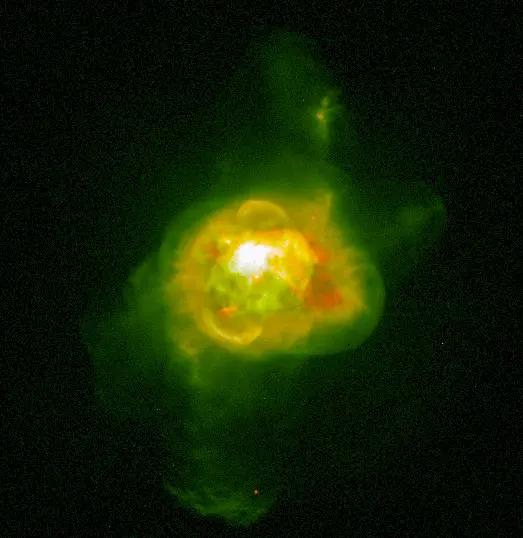
Planetary nebula NGC 6210, image: Robert Rubin and Christopher Ortiz (NASA Ames Research Center), Patrick Harrington and Nancy Jo Lame (University of Maryland), Reginald Dufour (Rice University), and NASA (PD)